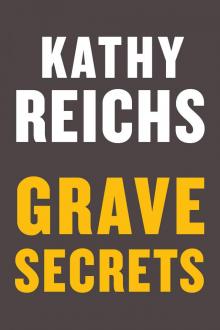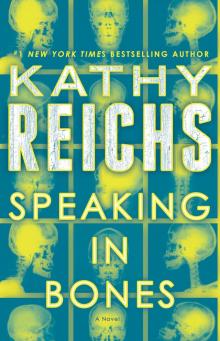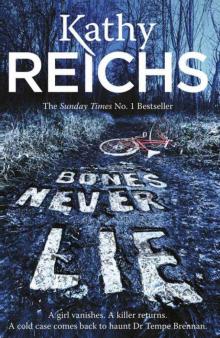- Home
- Kathy Reichs
Flash and Bones Page 2
Flash and Bones Read online
Page 2
The guard looked a question in our direction. Molene gestured “no” with both hands.
Denied access, the pair shouted through the downpour.
“How long has the body been out there?”
“Is it the kid who went missing from Bar Carolina?”
“Any tie-in to the Speedway?”
“Dr. Brennan—”
“Is the ME planning to—”
Hawkins, Molene, and I hurried into the office. The door slammed, cutting off the barrage of questions.
“Any chance it could be the Leonitus kid?” Hawkins referred to a young woman who’d vanished two years earlier after a night of barhopping with friends.
“How old is that sector?” I asked Molene.
“I’ll have to check the records.”
“Ballpark.” I removed my hard hat and vest and held them at arm’s length. Not that it mattered. I was dripping as much as they were.
“We stopped dumping in that area in 2005. That layer, I’d say late nineties to maybe 2002.”
“Then the vic ain’t Leonitus,” Hawkins said.
Or parts of her, I thought.
While Hawkins and Molene drove a motorized cart back out to retrieve the drum, I phoned Larabee. He said what I expected: See you tomorrow.
So much for lounging with my cat.
Thirty minutes later Jackson’s prize sat on plastic sheeting in the ME van, oozing muddy water and flecks of rust. Five minutes after that, it was making its way to Charlotte along with the Cabarrus County sandpit teeth and bones.
Officer Warner escorted me back to the interstate. After that I was on my own.
Between the downpour, rush hour, and the Race Week frenzy, vehicles were backed up to Minneapolis. Fortunately, that was opposite to my direction of travel, though westbound traffic was also heavy. While lurching and braking my way toward home, I wondered about the person we’d just recovered.
A whole body? A tight fit for a thirty-five-gallon container, but not impossible. Dismembered parts? I hoped not. A partial corpse would mean a return to the landfill for a systematic search.
That prospect was decidedly unappealing.
Friday promised a repeat of Thursday. Hot and sticky with more afternoon storms.
Wouldn’t affect me. I’d be stuck in the lab all day.
After a quick breakfast of granola and yogurt, I drove downtown. Or uptown, as Charlotteans prefer.
The Mecklenburg County medical examiner occupies one end of a featureless brick box that spent its early years as a Sears Garden Center. The box’s other end houses satellite offices of the Charlotte-Mecklenburg Police Department. Devoid of architectural charm save a slight rounding of the edges, the building is located at College and Tenth, just a hair outside the fashionable heart of uptown. Though plans exist to develop the site and move the facility, so far the MCME has stayed put.
Works for me. The place is just ten minutes from my town house.
At 8:05 I parked in the small tentacle of lot facing the MCME entrance, gathered my purse, and headed for the double glass doors. Across College, a half-dozen men sat or leaned on a wall bordering a large vacant lot. All wore the hodgepodge of ratty clothing that is the uniform of the homeless.
Beyond them, a black woman was muscling a stroller along the sidewalk toward the county services building, struggling with the uneven pavement.
The woman stopped to tug upward on her tube top. Her eyes drifted in my direction. I waved. She didn’t wave back.
Entering the vestibule, I tapped on a window above a counter to my left. A chubby woman turned in her chair and peered through the glass. Her blouse was sharply pressed, her hair permed and fixed primly in place.
Eunice Flowers has worked for the MCME since sometime back in the eighties, when it moved from the basement of the old Law Enforcement Center to its present location. Monday through Friday, she screens visitors, blessing some with entry, turning others away. She also types reports, organizes documents, and keeps track of every shred of information generated throughout the analysis of the dead.
Smiling, Mrs. Flowers buzzed me in. “You were a busy lady yesterday.”
“Very,” I said. “Anyone else here?”
“Dr. Larabee will be in shortly. Dr. Siu is lecturing at the university. Dr. Hartigan is in Chapel Hill.”
“Joe?”
“Gone to collect some poor soul from a Dumpster. Bless his heart. It’s gonna be another hot one today.” Mrs. Flowers’s vowels could have landed her a role in Gone With the Wind.
“Is the landfill body getting any attention?”
“Made the Observer. Local section. I’ve answered a half-dozen calls already.”
Mrs. Flowers’s tidiness includes not just her person but everything around her. At her workstation, Post-it notes hang equidistant, paper stacks are squared, pens, staplers, and scissors are stowed when idle. It is an orderliness of which I am incapable. Unnecessarily, she adjusted a photo of her cocker spaniel.
“Do you still have the paper?”
“I’d like it back, please.” She handed me her neatly folded copy. “The Belk ad is good for twenty percent off on linens.”
“Of course.”
“The consult requests are on your desk. I believe Joe placed everything in the stinky room before he left.”
The facility has a pair of autopsy rooms, each with a single table. The smaller of the two has special ventilation to combat foul odors.
For decomps and floaters. My kind of cases.
Good choice, Hawkins. Though the sandpit bones would be relatively aroma-free, there was no telling about the landfill vic. And I was uncertain how best to free the remains from the asphalt. Depending on their condition, things could get messy.
Passing the cubicles used by the death investigators, I checked the erasable board on the back wall. Five new arrivals had been entered in black Magic Marker. A newborn found dead in her bed. A man washed ashore at Mountain Island Lake. A woman bludgeoned with a frying pan in her kitchen on Sugar Creek Road.
My sandpit recovery had been designated MCME 226-11. Though the bones and teeth were probably those of the missing housewife, that assumption could always prove false. Thus, a new case number was assigned.
The landfill remains had been designated MCME 227-11.
My office is in back, near those of the three pathologists. The square footage is such that, were I not on staff, the space might have been used for the storage of buckets and mops.
Unlocking the door, I tossed the newspaper onto my desk, dropped into the chair, and placed my purse in a drawer. Two consult requests lay on the blotter, both signed by Tim Larabee.
I started with the Observer. The article was on page three of the local section, just six lines of copy. The byline said Earl Byrne, the mushroom guy I’d spotted in the Focus.
My name was mentioned, and the fact that remains had been transported from the Morehead Road landfill to the ME office. I figured Byrne had seen Hawkins and Molene load the drum into the van. Combining that with the radio transmission from the Concord cops, he’d decided the story was solid.
Fair enough. Maybe exposure would help with an ID.
I pulled a pair of forms from plastic mini-shelving on a filing cabinet at my back, filled in the case numbers, and wrote brief descriptions of each set of remains and the circumstances surrounding their discoveries. Then I went to the locker room, changed to surgical scrubs, and crossed to the stinky room.
The sandpit bones were on the counter, in the brown evidence bag in which I’d placed them.
The landfill drum sat atop its mud-caked sheeting on a morgue gurney.
Since the missing housewife was higher up the queue, I decided to start there.
After assembling camera, calipers, clipboard, and a magnifying lens, I accessorized with a paper apron and mask and snapped on latex gloves. No match for the hard hat and vest, but the look was elegant in its own way.
By ten-fifteen I was done. x-rays, measurement, a
nd gross and microscopic observation revealed that the bones and teeth were compatible with the rest of the sandpit skeleton. Dental analysis would confirm the finding, but I was confident the parts I’d recovered belonged to the missing housewife.
And that she had indeed been murdered.
The hyoid, a delicate U-shaped bone from her throat, showed fractures on each of its wings. Such trauma almost always results from manual strangulation.
I was finalizing my notes when the phone rang in a cadence that indicated the call was internal.
“I have a gentleman here who wishes to see you.” Mrs. Flowers sounded flustered.
“Can’t Joe deal with him?”
“He’s still out.”
“I’m trying to focus on these cases,” I said.
“The gentleman says he has information that is extremely important.”
“Information about what?”
“The body from the landfill.”
“I can’t discuss that yet.”
“He thinks he knows who it is.” Hushed but excited.
“D. B. Cooper has finally turned up?” Snarky, but I’d heard this line many times before.
There was a moment of prim silence.
“Dr. Brennan. This man is not a crackpot.”
“What makes you so sure?”
“I’ve seen his picture in People magazine.”
GENERATION? UPBRINGING? HORMONES? I’VE NO CLUE THE reason, but in the presence of attractive Y-chromosomers, Mrs. Flowers blushes and her voice goes breathy.
“Dr. Brennan, I’d like to present Wayne Gamble.”
I looked up.
Standing in my doorway was a compact man with intense brown eyes and dark blond hair cut short and combed straight back. He wore jeans and a black knit polo with a Hilderman Motorsports logo stitched in red.
I laid down my pen.
Gamble stepped into the office and held out a hand. His grip was firm but not a testosterone crusher.
“Please have a seat.”
I gestured at a chair on the far wall. Meaning six feet from my desk. Gamble dragged it forward, sat, and planted his palms on his knees.
“Can I get you anything?” Marilyn crooning birthday wishes to the prez. “Water? A soft drink?”
Gamble shook his head. “No, ma’am.”
Mrs. Flowers remained fixed in the hall.
“Perhaps it’s best if you close the door,” I said gently.
Cheeks flaming, Mrs. Flowers did as requested.
“What can I do for you, Mr. Gamble?”
For a moment the man just stared at his hands. Reconsidering? Choosing his words?
I wondered at his reticence. After all, he’d come to me. Why such caution?
“I’m the jackman for Stupak’s fifty-nine car.”
My confusion must have been obvious.
“The Sprint Cup Series? Sandy Stupak?” he said.
“He’s a NASCAR driver.”
“Sorry. Yeah. Stupak drives the fifty-nine Chevy for Hilderman Motorsports. I’m on his pit crew.”
“Thus your photo in People.”
Gamble gave a self-deprecating grin. “They did a spread on racing and I got caught in some of the shots. The photographer was aiming at Sandy.”
“You’re in town for the Coca-Cola 600?” Flaunting my minuscule knowledge of NASCAR.
“Yeah. Actually, I live in Kannapolis, just down the road. Raised there.” Again Gamble hesitated, obviously uncomfortable. “My sister, Cindi, was two years older than me.”
The verb tense clued me where this was going.
“Cindi went missing her senior year of high school.”
I waited out another pause.
“I read in the paper you found a body in the dump out by the Speedway. I’m wondering if it could be her.”
“When did your sister disappear?”
“1998.”
Molene thought the drum holding our John/Jane Doe had eroded from an area of the landfill active at that time. I kept this fact to myself. “Tell me about her.”
Gamble pulled a snapshot from his pocket and flipped it onto my desk. “That was taken just a couple of weeks before she went missing.”
Cindi Gamble looked like she could have modeled for yogurt ads. Her teeth were perfect, her skin flawless and lousy with health. She had a blond pixie bob and wore a silver loop in each ear.
“Are those cars on her earrings?” Returning the photo.
“Cindi wanted to be a NASCAR driver in the worst way. Drove go-karts from the time she was twelve, moved up to legends.”
Again, I must have looked lost.
“Little single-seat cars for beginners. Legends driving trains kids so they can advance to real short-course racing.”
I nodded, not really understanding.
Gamble didn’t see. His eyes were on the photo still in his hand. “Funny how life turns out. In high school I was all about football and beer. Cindi hung with the science geeks. Loved cars and engines. NASCAR was her dream, not mine.”
Though anxious for Gamble to get on with his story, I didn’t interrupt.
“The summer before her senior year, Cindi started dating another wannabe driver, a guy named Cale Lovette. That fall, Cindi and Cale both vanished. Bang. Gone without a trace. No one’s seen them since.”
Gamble’s eyes met mine. In them I saw apprehension. And resurrected pain.
“My folks went crazy. Posted flyers all over town. Handed them out in malls. Nothing.” Gamble wiped his palms on his jeans. “I’ve got to know. Could that body be my sister?”
“What makes you think Cindi is dead?”
“The police said the two of them left town together. But Cindi’s whole life was NASCAR. I mean, she was on fire to drive. What better place to do that than Charlotte? Why would she just pick up and leave? And she’s never turned up anywhere else.”
“There was an investigation?”
Gamble snorted in disgust. “The cops poked around for a while, decided Cindi and Cale took off to get married. She was too young to do that without parental approval.”
“You doubt that theory?”
Gamble’s shoulders rose, fell. “Hell, I don’t know what to believe. Cindi didn’t confide in me. But I’m sure my folks would never have agreed to her marrying Cale.”
“Why?”
“She was seventeen. He was twenty-four. And rolled with a pretty rough crowd.”
“Rough?”
“White-supremacist types. Hated blacks, Jews, immigrants. Hated the government. Back then I suspected Cale’s racist buddies might be involved. But what would they have against Cindi? I don’t know what to think.”
Gamble shoved the photo back in his pocket.
“Mr. Gamble, it’s unlikely that the person we recovered is your sister. I’m about to begin my analysis. If you’ll leave contact information, I’ll inform you when I’ve finished.”
I passed across pen and paper. Gamble scribbled something and handed them back.
“Should it prove necessary, could you obtain Cindi’s dental records?”
“Yeah.”
“Would you or another maternal relative be willing to provide a DNA sample?”
“It’s just me now.”
“What about Lovette?”
“I think Cale’s father still lives around here. If I can find a listing, I’ll give him a call.”
Gamble got to his feet.
I rose and opened the door.
“I’m truly sorry for your loss,” I said.
“I just keep pedaling to stay out front.”
With that odd comment, he strode down the hall.
I stood a moment, trying to recall news stories about Cindi Gamble and Cale Lovette. The disappearance of a seventeen-year-old kid should have generated a headline or two. Angel Leonitus certainly had.
I could not remember seeing anything on Gamble.
Vowing to research the case, I headed back to the stinky room.
The landfill dru
m was as I’d left it. I was circling the gurney, considering options, when Tim Larabee pushed through the door wearing street clothes.
Mecklenburg County’s chief medical examiner is a runner. Not the healthy knock-out-three-miles-in-the-neighborhood variety but the train-for-a-marathon-in-the-Gobi-Desert zealot. And it shows. Larabee’s body is sinewy and his cheeks are gaunt.
“Oh boy.” Larabee’s deep-set eyes were pointed at the gurney.
“Or girl,” I said. “Take a look.” I indicated the open end of the drum.
Larabee crossed to it and peered at the hand. “Any idea how much more is in there?”
I shook my head. “Can’t x-ray because of the metal and the density of the fill.”
“What’s your take?”
“Someone stowed a body or body parts, then filled the drum with asphalt. The hand was up top and became visible when the lid came off and the asphalt eroded.”
“Tight fit for an adult, but I’ve seen it done. Any dates on the sector where they found this thing?”
“A landfill worker said that area of the dump closed in 2005.”
“So it’s not Leonitus.”
“No. She’s too recent.”
“As of Monday, we got us another MP. Man came from Atlanta to Charlotte for Race Week. Wife reported him missing.” Larabee was studying the drum. “How will you get it out?”
How will I get it out?
Great.
Though I’d never freed remains from asphalt, I had liberated corpses from cement. In each case, because fats from the surface tissues had created a nonbinding surface, a small void had surrounded the body. I anticipated a similar situation here.
“The drum is no problem. We’ll cut through that. The asphalt is trickier. One option is to saw at horizontal and lateral planes to the block, then use an air hammer to create propagation cracks.”
“Or?”
“The other option is to chisel away as much asphalt as possible, then dip the block in solvent to dissolve what remains.”
“What kind of solvent?”
“Acetone or turpentine.”
Larabee thought a moment, then, “Asphalt and cement work damn well as sealants, so there might be fresh tissue preserved in there. Go with Plan A. Joe can help.”

 Two Nights
Two Nights The Bone Collection: Four Novellas
The Bone Collection: Four Novellas Fatal Voyage
Fatal Voyage 206 Bones
206 Bones Bones to Ashes
Bones to Ashes Terminal
Terminal Monday Mourning
Monday Mourning Flash and Bones
Flash and Bones Cross Bones
Cross Bones Devil Bones
Devil Bones Break No Bones
Break No Bones Swamp Bones
Swamp Bones Déjà Dead
Déjà Dead Shock
Shock Spider Bones
Spider Bones Death Du Jour
Death Du Jour Grave Secrets
Grave Secrets Trace Evidence: A Virals Short Story Collection
Trace Evidence: A Virals Short Story Collection Bones on Ice
Bones on Ice The Bone Code
The Bone Code Bones in Her Pocket
Bones in Her Pocket Seizure:
Seizure: Speaking in Bones
Speaking in Bones Deadly Decisions
Deadly Decisions Spike
Spike Bones Never Lie
Bones Never Lie Bones of the Lost
Bones of the Lost Virals 03.5 - Swipe
Virals 03.5 - Swipe Exposure
Exposure A Conspiracy of Bones
A Conspiracy of Bones Shift (tory brennan)
Shift (tory brennan) Bones of the Lost: A Temperance Brennan Novel tb-16
Bones of the Lost: A Temperance Brennan Novel tb-16 Virals tb-1
Virals tb-1 Bones Are Forever tb-15
Bones Are Forever tb-15 Code tb-3
Code tb-3 Seizure tb-2
Seizure tb-2 Deadly Descisions
Deadly Descisions Spider Bones: A Novel
Spider Bones: A Novel